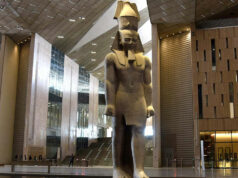How one man’s legacy put Barossa on the wine-making map.
WORDS SHERWIN A. LAO
Some of the finest and most expensive wines in Australia come from the Barossa Valley, a huge viticultural destination that’s a lazy one-hour drive from Adelaide. In total, the wine-growing region of Barossa measures 10,350 hectares, roughly two-thirds of the Médoc vineyards in Bordeaux, France.
Known both for its Barossa Valley Shiraz for red, and its Eden Valley Riesling for white, Barossa has wine making traditions dating back to the 19th century (among the oldest from New World wines). In the town of Tanuda, where the Peter Lehmann Winery is located, one will find Shiraz — or Syrah, if you’re French — vines that were planted in the late 1840s. Still used for commercial wine production by Turkey Flat Vineyards, the heirloom vine produces “floral, elegant, well-structured” wines. Other grape varieties grown in the Barossa Valley include Grenache, Mourvedre, Cabernet Sauvignon, Chardonnay and Semillon.
Aside Turkey Flat Vineyards, famous Aussie wineries on the Barossa map include: Penfolds, Wolf Blass, Torbreck, Jacob’s Creek, Henschke, Yalumba, Grant Burge, St. Hallet, Saltram, and, of course, the aforementioned Peter Lehmann Winery. On a trip to Adelaide in 2001, this writer visited the Australian National Wine Center, which had recently opened. Located near the Adelaide Botanical Gardens, the center is a unique architectural feat made from metal and wood, which mimics the shape of an oak barrel. Visitors were greeted by a hologram of Peter Lehmann saying “Welcome to the Australian Wine Center,” which clues you in on the man’s stature: He is the face not only of Barossa, but of all of South Australia.
Hard-knocks hero
Peter Lehmann, born in 1930, was raised in the Barossa village of Angaston. He started his wine making career at the unbelievably young age of 17, when he left school and became the apprentice wine maker at Yalumba in 1947. For the next 12 years, Lehmann was educated in the proverbial school of hard knocks. He learned not only to hone his wine making skills but the general business side of wines. At the ripe age of 29, Lehmann, now an accomplished figure in the industry, was offered the top wine maker-cum-manager position at Saltram, a historic winery.
For close to 20 years, he worked hand in hand with more than 60 grape growers in Barossa, securing long-term relationships that granted Saltram access to the best available red grapes during Australia’s wine boom. Saltram was at its pinnacle during Lehmann’s 20-year tenure, but in the mid-to-late 1970s, red wine lost ground to fruity white wines. Because of financial strain, Saltram owners forced Lehmann to renege on his deals with red grape growers, disastrously affecting their livelihood.
It was at this time that Lehmann left Saltram and opened his eponymous winery to nurture the grape growers who depended on him. This is how Lehmann’s legend as a local savior was born and the rest, as they say, is history. Aside from making some of the best wines in Barossa, Lehmann mentored Australia’s next-generation wine makers. Lehmann, who did it all in the industry, was awarded the prestigious International Wine Challenge Lifetime Achievement Award in 2009. The winery, as with individual Peter Lehmann wines, has been hailed by the most credible wine award-giving bodies in the world. This was the legacy of Lehmann, who passed away in June 2013 at the age of 82.

A continuing story
On December 19, 2014, Casella Family Brands, the mother company of Yellow Tail, the top exported brand from Australia, officially announced its purchase of the Peter Lehmann Winery. John Casella, managing director of Casella Family Brands declared that Peter Lehmann wines were a great addition to the Casella wine portfolio dominated by the enormously successful Yellow Tail (stylized [yellow tail]).
Peter Lehmann gives the Casella Family Brands an immediate strong entry in the highly competitive, but more lucrative, premium wine segment. The sale of Peter Lehmann Winery to Casella Family Brands was done with the consent of Lehmann’s widow, Margaret Lehmann, and the winery’s erstwhile majority shareholder, the Swiss-based Hess Group. The synergy created by the purchase could not have been more ideal, as Yellow Tail has an enviable export position in Australia: in 2013, prior to acquiring Peter Lehmann, Casella Family Brands had already sold a billion Yellow Tail bottles. This marketing savvy augurs well for Peter Lehmann on a global platform. Casella Family Brands has also promised to honor Peter Lehmann’s legacy by nurturing the relationships he formed with Barossa’s grape growers, maintaining the status quo on access to the highest quality grapes, and preserving the premium Barossa signature. This is a win-win situation for both Casella Family Brands and Peter Lehmann Winery, and for us wine lovers too.
(Sherwin A. Lao has been a member of the Federation Internationale des Journalists et Ecrivains du Vin et des Spiritueux or FIJEV since 2010.)



